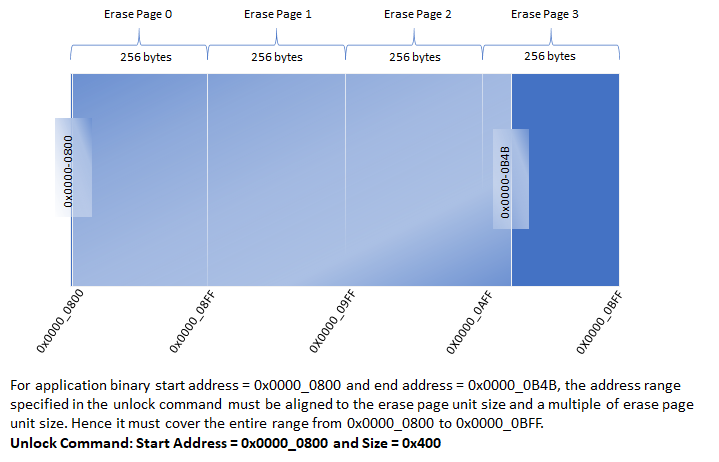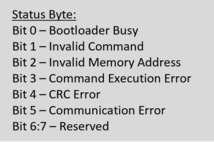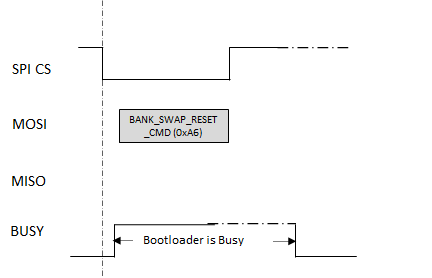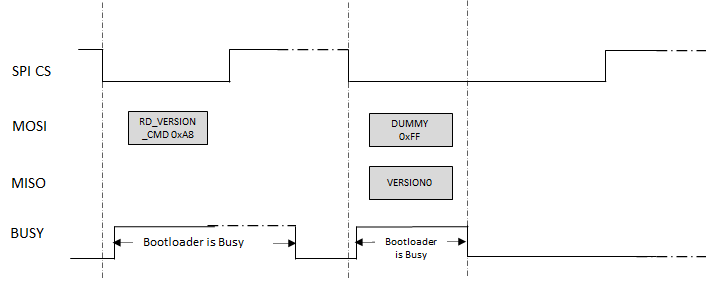1.3.1.5 SPI Bootloader Protocol
Each command argument is of 4 bytes and must be sent in little-endian (LSB first) format.
Unlock Command (0xA0)
Unlock command is used to specify the application start address and size of the application. Unlock command must be issued before issuing any other command.
Payload:
Arg 0 - Application start address. The start address is device dependent and must be aligned to an Erase Unit boundary which is also device dependent.
Arg 1 - Application size. It must be rounded off to the nearest erase unit size .

The memory address range specified in Unlock command will be used to validate the addresses sent for other commands. The memory address specified by all other commands must lie within the address range specified for the Unlock command.
Bootloader will calculate CRC over the entire range of memory specified by the Unlock command

Erase Command (0xA1)
Erase command erases a flash page as specified by the Erase Page Address argument
Payload:
Arg 0 - Starting memory address of the flash page being erased.
The flash page being erased must lie within the address range specified by the Unlock command else the bootloader will set the INVALID ADDRESS error bit in the status byte.
If the command is accepted successfully, the bootloader will set the BUSY bit in the status byte. While the bootloader is busy, the BUSY line GPIO will also be asserted "Busy". The "Busy" state of the GPIO can be configured to Active High or Active Low in the underlying SPI PLIB configuration in MCC. Once the bootloader has completed the erase operation and is ready to accept new commands from the host, the BUSY bit in the status byte is cleared and the BUSY line GPIO is de-asserted to "Not Busy" state. The host application must poll the BUSY line, and once de-asserted, it must send command to read the status byte and ensure that the command is completed successfully (status byte indicates bootloader is not busy and no error bits are set) before issuing a new command.

Program Command (0xA2)
Program command is used to send the image data
Payload:
Arg 0: Number of bytes to program. It must be a multiple of the flash page size. Depending on the value specified, one or more flash pages within the erase unit can be programmed. For example, if the erase row size is 256 bytes and program page size is 64 bytes, the number of bytes to program can either be 64, 128, 192 or 256.
Arg 1: Program Memory Address. It must be aligned to the start address of the flash page being programmed.
The flash page being programmed must lie within the address range specified by the Unlock command; else the bootloader will set the INVALID ADDRESS error bit in the status byte.
If the command is accepted successfully, the bootloader will set the BUSY bit in the status byte. While the bootloader is busy, the BUSY line GPIO will also be asserted "Busy". Once the bootloader has completed the program operation and is ready to accept new commands from the host, the BUSY bit in the status byte is cleared and the BUSY line GPIO is de-asserted to "Not Busy" state. The host application must poll the BUSY line, and once de-asserted, it must send command to read the status byte and ensure that the command is completed successfully (status byte indicates bootloader is not busy and no error bits are set) before issuing a new command.
The bootloader host application must ensure that the flash page being programmed is erased before issuing the Program Command

Verify Command (0xA3)
Verify command is used to verify the programmed application image.
Payload:
Arg 0: Application Image CRC. CRC is a standard IEEE CRC32 with a polynomial of 0xEDB88320
The bootloader host application must calculate the CRC of the application image over the entire memory range specified in the Unlock command and provide it to the bootloader. The CRC is a standard IEEE CRC32 with a polynomial of 0xEDB88320.
The bootloader upon receiving the Verify command, calculates the CRC over the range of addresses specified by the Unlock command by reading the flash memory contents and compares it with the received CRC value.
If the command is accepted successfully, the bootloader will set the BUSY bit in the status byte. While the bootloader is busy, the BUSY line GPIO will also be asserted "Busy". Once the bootloader has completed the verify operation and is ready to accept new commands from the host, the BUSY bit in the status byte is cleared and the BUSY line GPIO is de-asserted to "Not Busy" state. The host application must poll the BUSY line, and once de-asserted, it must send command to read the status byte and ensure that the command is completed successfully (status byte indicates bootloader is not busy and no error bits are set) before issuing a new command.
If the calculated CRC and received CRC values do not match, the CRC_ERROR bit is set in the Status byte.

Reset Command (0xA4)
Reset command is used to exit the bootloader and run the application. The system takes a reset after receiving the Reset Command

Read Status Command (0xA5)
Returns the bootloader status.


Flash Bank Swap and Reset Command (0xA6)
Resets the device and swaps the flash bank.

This command is enabled only when Fail safe update feature is selected for bootloader and the device has support for Dual Bank update
Bank Swap and Reset command is used to Swap the inactive bank to active bank and trigger a reset to exit the bootloader and run the new application programmed in the inactive bank
Device Configuration Program (0xA7)
Programs the Device configuration (Fuse configurations)

Read Version (0xA8)
Reads the bootloader version number

